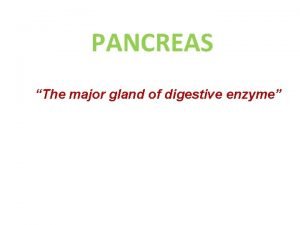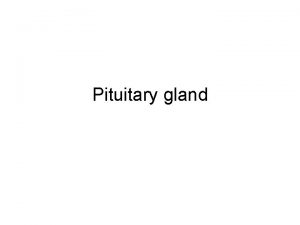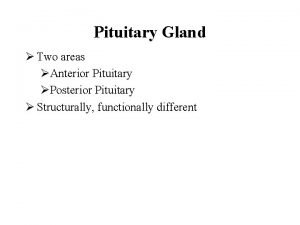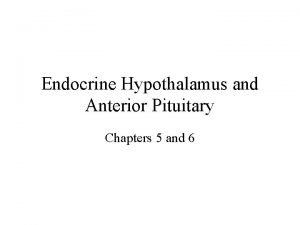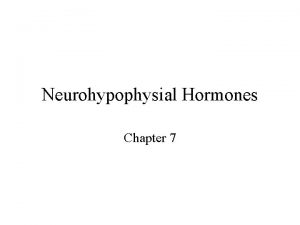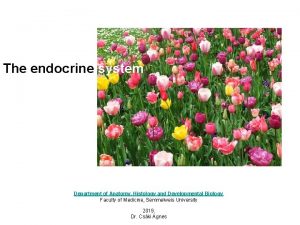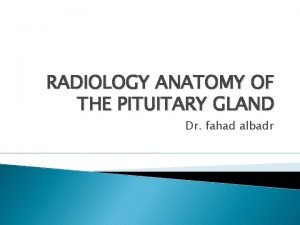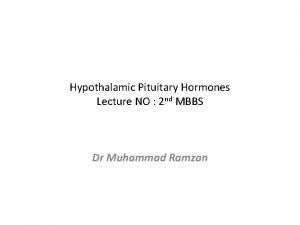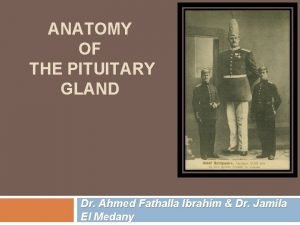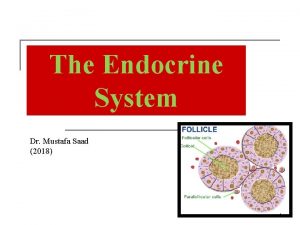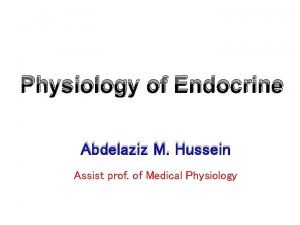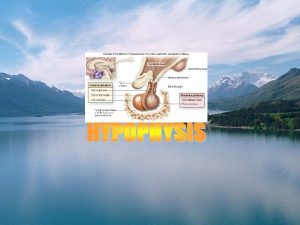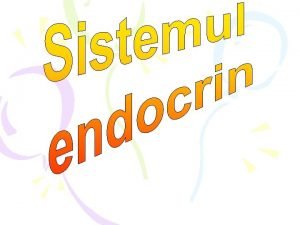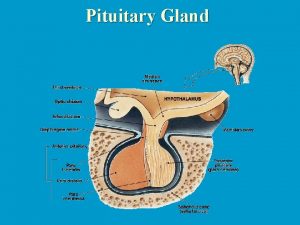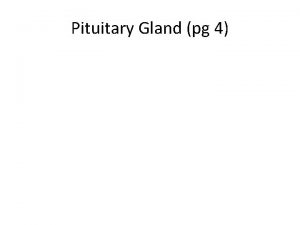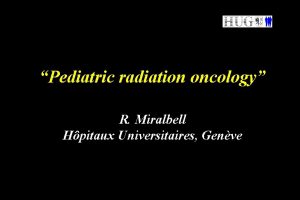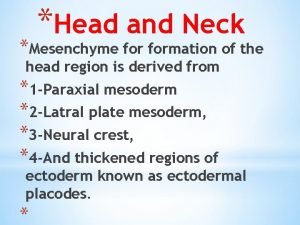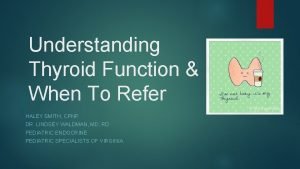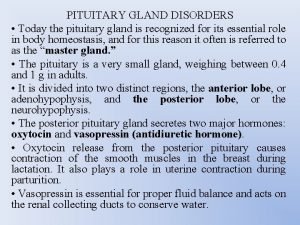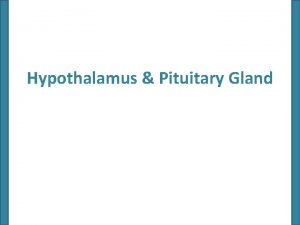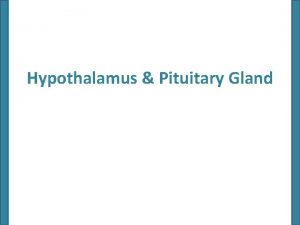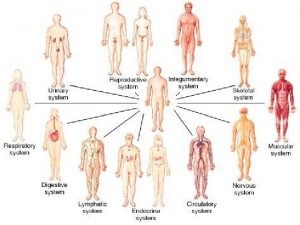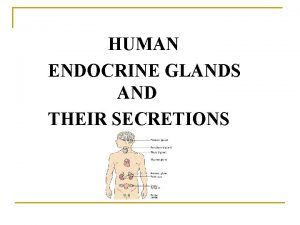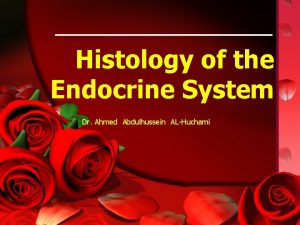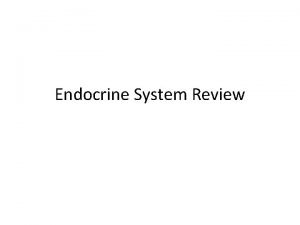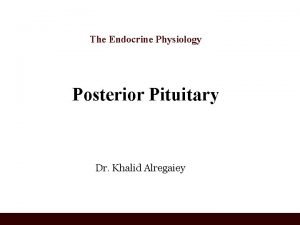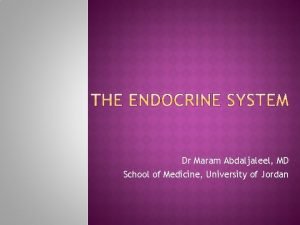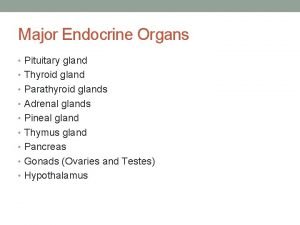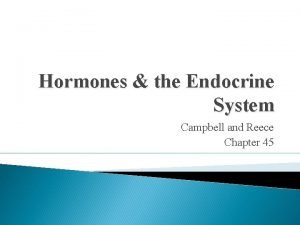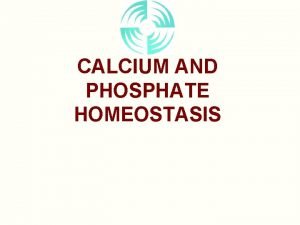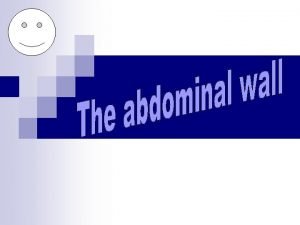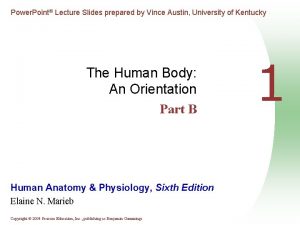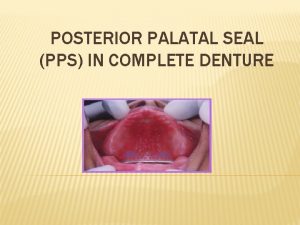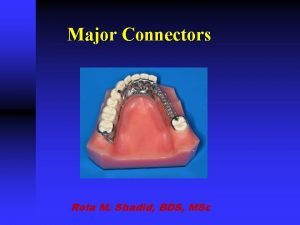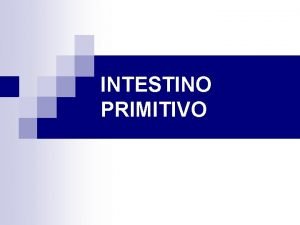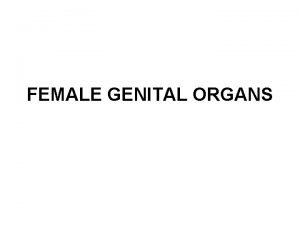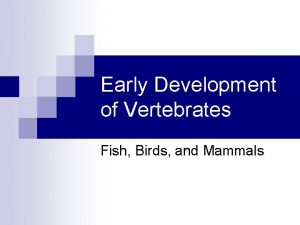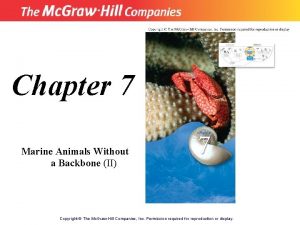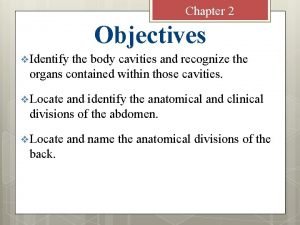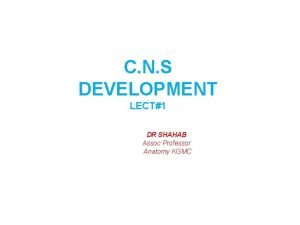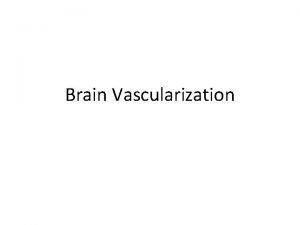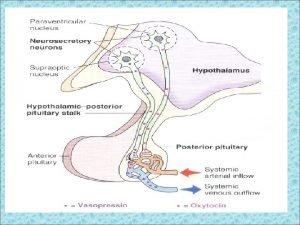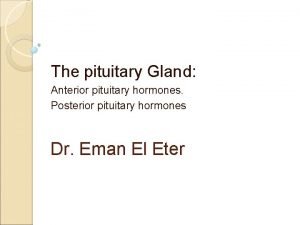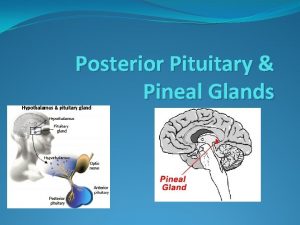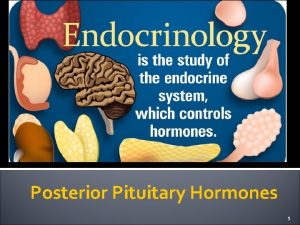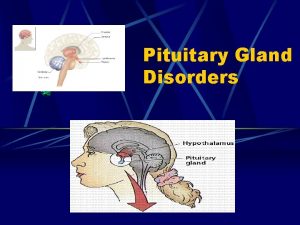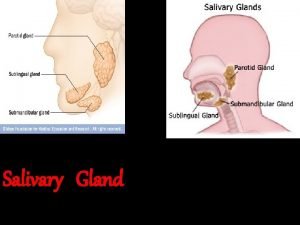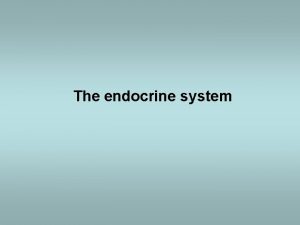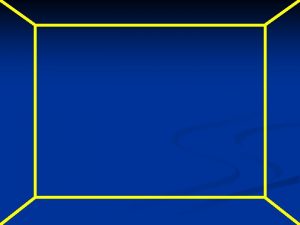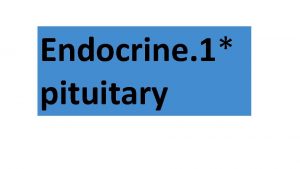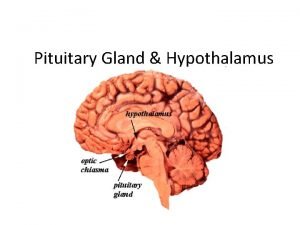Pituitary Gland Two areas Anterior Pituitary Posterior Pituitary






















































- Slides: 54

Pituitary Gland Ø Two areas ØAnterior Pituitary ØPosterior Pituitary Ø Structurally, functionally different


The pituitary gland HYPOTHALAMUS Hypothalamus secretes releasing factors ADH & oxytocin carried from hypothalamus INFUNDIBULUM Thyroid stimulating hormone Adrenocorticotropic hormone Gonadotropic hormones (FSH & LH) Growth hormone Prolactin Antidiuretic hormone ANTERIOR LOBE POSTERIOR LOBE Oxytocin

Anterior pituitary gland:

Cell types in anterior Pituitary Chromophilic cells Ø Somatotrophs- GH Ø Lactotrophs- Prolactin Ø Corticotrophs- ACTH Ø Thyrotrophs- TSH Ø Gonadotrophs- FSH, LH Chromophobic cells Folliculostellate cellsØ cytokines like IL 6

Growth hormone:



Actions of growth hormone:

Mechanism of action • Receptor on the membrane of the cell • Acts via JAK-STAT pathway

PHYSIOLOGICAL ACTION OF GH

Growth Hormone Direct effect Indirect effect Somatomedins Growth Bone, Cartilage

1. Action on growth: • Stimulates the growth of the skeleton. Specific action on the epiphyseal cartilage. Causes a linear growth of body. Increases growth of the skeletal frame by ü Proline collagen ü Incorporates sulfate into chondroitin. ü Increased deposition of protein by the chondrocytic and osteogenic cells that cause bone growth. ü Increased size and no of chondrocytes. ü Prechondrocytes ü Converting chondrocytes into osteogenic cells, thus causing deposition of new bone and increases osteoblastic activity.

• Stimulates the growth of the viscera. • Increases the skeletal muscle mass by increasing protein synthesis. • Pubertal and gonadal growth- promotes pre pubertal sexual maturation.

GH increase the length of the bones till fusion of epiphysis with the shaft Once the fusion occurs, GH looses the ability to increase the length of the bones. However, since the GH strongly stimulates osteoblasts, the bone continues to become thick throughout the life (jaw bone, skull bone)

2. Action on metabolism:

METABOLISM On. CARBOHYDRATE carbohydrate metabolism. Ø Decrease in the uptake of the glucose by the cells. Ø Decrease in the peripheral utilization of glucose for the production of the energy. Ø Facilitates hepatic neoglucogenesis. Ø Decreases insulin sensitivity. Ø Diabetogenic effect.

On fat metabolism: Lipid Metabolism Ø Is lipolytic – releases fatty acid from adipose tissue. Ø Increases fatty acids in the body fluids. Ø Enhances conversion of fatty acids to acetyl co-A and used as source of energy. Ø Can be Ketogenic in excessive amounts

On protein metabolism: Protein Metabolism Ø is a protein anabolic hormone. Ø Enhancement of amino acid transport through the cell membranes. Ø Enhancement of protein synthesis by ribosomes. Ø Increased transcription of DNA from RNA. Ø Decreased catabolism of protein and amino acid - “Protein sparer”

• On electrolytes: Conserves the electrolytes (Ca, Na, phospahte). 3. Action on milk production. Lactogenic and mammogenic activity. Help in the maintenance of milk secretion along with thyroxine and Prolactin. 4. Action on erythropoiesis: Increase erythropoietin production.

5. Action on lymphocytes: Stimulates the growth of the lymphoid tissue and proliferation of lymphocytes. 6. Action on gonads: Stimulates the growth of genitalia.

Biological Actions Of Human Growth Hormone Adipose Tissue Liver RNA synthesis Muscle Lipolysis Protein synthesis Glucose Uptake Somatomedin AA Uptake gluconeogenesis Protein Synthesis Somatomedins IGF- 1 and 2 Bone Chondrocytes

Factors influencing GH release • Stimulates ü Nor epinephrine ü Dopamine agonist ü Exercise ü Stress ü Hypoglycemia ü Starvation • Inhibits ü Dopamine blockers ü Obesity ü Hyperglycemia ü Chronic steroid treatment

Regulation of Growth Hormone Body growth.

Applied aspects

Abnormalities in GH Secretion 1. Hyposecretion: Dwarfism 2. Hypersecretion: Gigantism and Acromegaly

Hypersecretion of GH Leads to • Gigantism- In children • Acromegaly - In adults

Gigantism • • • occurs right from childhood. Before fusion of epiphysis. Abnormal height (7 feet and above. ) Forward bending of vertebral column ( Kyphosis ). High blood sugar( Diabetes mellitus) Limb-trunk proportion is abnormal.

22 yrs Twins


Ø Acromegaly Ø After fusion of epiphysis. Ø Enlargement of hands and feet. Ø Enlargement of membranous bones like cranium, nose, supraorbital ridges and lower jaw. Ø The lower jaw is protruded (Prognantism). Ø Bowing of spine (Kyphosis)

Ø Ø Over growth of malar, frontal and facial bones are thickened with thickening of skin and edema (Acromegalic or guerrilla face) Ø General overgrowth of body hair Ø Enlargement of visceral organs (lungs, thymus, heart, liver, spleen) Ø Bitemporal hemianopia Ø Hyperglycemia or glycosuria occur resulting in diabetes mellitus





• In the above photographs, we see a woman at 16, 33 and 52 years of age who has a condition caused by excessive secretion of growth hormone during adulthood. This condition is characterized by disproportionate growth in the jaw, hands and nose.

Dwarfism • • Disorder in children Characterized by stunned growth. No mental retardation. Sexual growth: Occurs normally in these individuals. Cause • Decrease GH secretion • Due to deficiency of secretion of GHRH • Atrophy of the acidophil cells



Panhypopituitarism Decreased secretion of all anterior pituitary hormones. The decrease in the secretion might be congenital or it may occur suddenly at any time during the life of the individual

Simmond’s disease • Occurs mostly in panhypopituitarism • Atrophy of anterior pitutiary gland

Laron dwarfism • The secretion of GH is normal or high • Unresponsiveness of GH receptors.

Action of prolactin:

1. Causes lactogenesis in the breast: • Initiates milk secretion and then maintains the same. • Stimulates the growth of alveoli and duct systems. 2. Suppresses menstrual cycle. 3. Stimulates erythropoiesis. 4. Maternal behavior.

5. Immunological function. 6. Increases the conversion of 25(OH) cholecalciferol to 1 -25(OH)2 to cholecalciferol. Increase in males-> impotency.

Regulation of prolactin secretion.

1. By hypothalamus. PRH, PIH. 2. Oestrogen and progesterone. High levels – Decrease the secretion. 3. Suckling of the breast and stimulation of vagina during coitus – Stimulates prolactin secretion. 4. Dopamine agonist- Decrease prolactin secretion.

Applied aspects

Hyper Prolactinemia: • In females: Galactorrhoea, Amenorrhoea and infertility. • In males : Sexual impotency

ADRENOCORTICOTROPIC HORMONE • Secreted from corticotrophs of anterior pitutiary • Proopiomelanocortin beta lipotropin • ACTH has intrinsic α- MSH activity.



Factors influencing ACTH release • Stimulates ü CRH, ADH ü Stress ü Sleep wake cycle ü Anxiety, depression ü Seratonin ü Alpha receptor agonist, beta antagonist • Inhibits ü Cortisol ü ACTH ü Somatostatin ü GABA
 Pituitary gland and pineal gland spiritual
Pituitary gland and pineal gland spiritual Thyoid gland
Thyoid gland Pancreas artery
Pancreas artery The embryonic origin of the anterior pituitary gland is
The embryonic origin of the anterior pituitary gland is Anterior pituitary gland
Anterior pituitary gland Difference between anterior and posterior pituitary
Difference between anterior and posterior pituitary Difference between anterior and posterior pituitary
Difference between anterior and posterior pituitary Follicular epithelium
Follicular epithelium Pituitary gland venous drainage
Pituitary gland venous drainage Division of pituitary gland
Division of pituitary gland Nerve supply to pituitary gland
Nerve supply to pituitary gland Hypophyseal fossa and pituitary gland
Hypophyseal fossa and pituitary gland Diaphragma sellae
Diaphragma sellae Exocrine glands function
Exocrine glands function Hypophyseal fossa and pituitary gland
Hypophyseal fossa and pituitary gland Hypersecretion of prolactin
Hypersecretion of prolactin Htpothalamus
Htpothalamus Hormoni hidrosolubili
Hormoni hidrosolubili Evolution of pituitary gland
Evolution of pituitary gland Pituitary gland hormones
Pituitary gland hormones Pituitary gland
Pituitary gland Tuberculum impar
Tuberculum impar Gland
Gland Pituitary gland thyroid
Pituitary gland thyroid Pituitary gland disorders
Pituitary gland disorders Hyposecretion of prolactin
Hyposecretion of prolactin Hypothalamus hormones
Hypothalamus hormones Pituitary gland function
Pituitary gland function Function of pituitary gland in points
Function of pituitary gland in points Histology of pituitary gland
Histology of pituitary gland 30 / 4
30 / 4 What is the name
What is the name Embryonic development of pituitary gland
Embryonic development of pituitary gland Posterior pituitary hormones
Posterior pituitary hormones Anterior pituitary
Anterior pituitary Anterior pituitary
Anterior pituitary Anterior pituitary hormones
Anterior pituitary hormones Four oval masses on posterior thyroid gland
Four oval masses on posterior thyroid gland Anterior stroke vs posterior stroke
Anterior stroke vs posterior stroke Proximal distal
Proximal distal Posterior abdominal wall
Posterior abdominal wall The anterior and posterior body cavities
The anterior and posterior body cavities Vibrating line palate
Vibrating line palate Anterior posterior major connector
Anterior posterior major connector Major connector
Major connector Intestino faríngeo
Intestino faríngeo Lingual plak protez
Lingual plak protez Tuba uterina
Tuba uterina Cleavage in birds
Cleavage in birds Animals with backbone
Animals with backbone Ventral vs dorsal
Ventral vs dorsal Medial and lateral
Medial and lateral Three primary brain vesicles from anterior to posterior
Three primary brain vesicles from anterior to posterior Post inf cerebellar artery
Post inf cerebellar artery Ventral cavity consists of
Ventral cavity consists of


